Asetek Forte Button Box and Wheel rims
The success of Aalborg-based Asetek Simsports can definitely not be denied. This prominent sim racing giant has firmly established itself on the map in recent years. Across all levels of the high-end sim racing hardware market, Asetek has released products to cater to racers with both high and mid-high budgets.
In October of last year, Asetek launched a series of products that significantly expanded their range of steering wheels. While they previously only had the La Prima and Forte Formula steering wheels, they have now introduced a solution to meet the needs of other types of steering wheels. The solution Asetek has released for this purpose is the La Prima and Forte Button boxes, which can be equipped with six individual steering wheels, allowing users to customize their steering setup. Like other Asetek products, the La Prima Button Box is the entry-level model, offering a simpler and more affordable option compared to the Forte Button Box. The La Prima variant is available from €284.34 including VAT, and the Forte Buttonbox is priced at €387.19 including VAT. The individually available steering wheels each have a price of €120.99, with only the Round Comfort+ steering wheel having a higher price at €163.34 including VAT. All products are available through Asetek’s webshop, where you can also get a 5% discount on your order using the discount code “simraceblognl.”
Asetek has offered us the opportunity to test and share our thoughts on their new products, an offer we couldn’t resist. We’ve received a substantial package from Asetek, including the Forte Buttonbox, the Round Comfort+ steering wheel, the Open D Suede steering wheel, and the Closed D Black Leather steering wheel. As a bonus, they’ve also included a set of Clutch Paddles valued at €45.97 including VAT, which can be mounted on the button box. The entire steering configuration we’ll be testing has a total price of €564.15 for the setups with the Open and Closed D steering wheels and a price of €596.50 for the setup with the Round Comfort+ steering wheel.
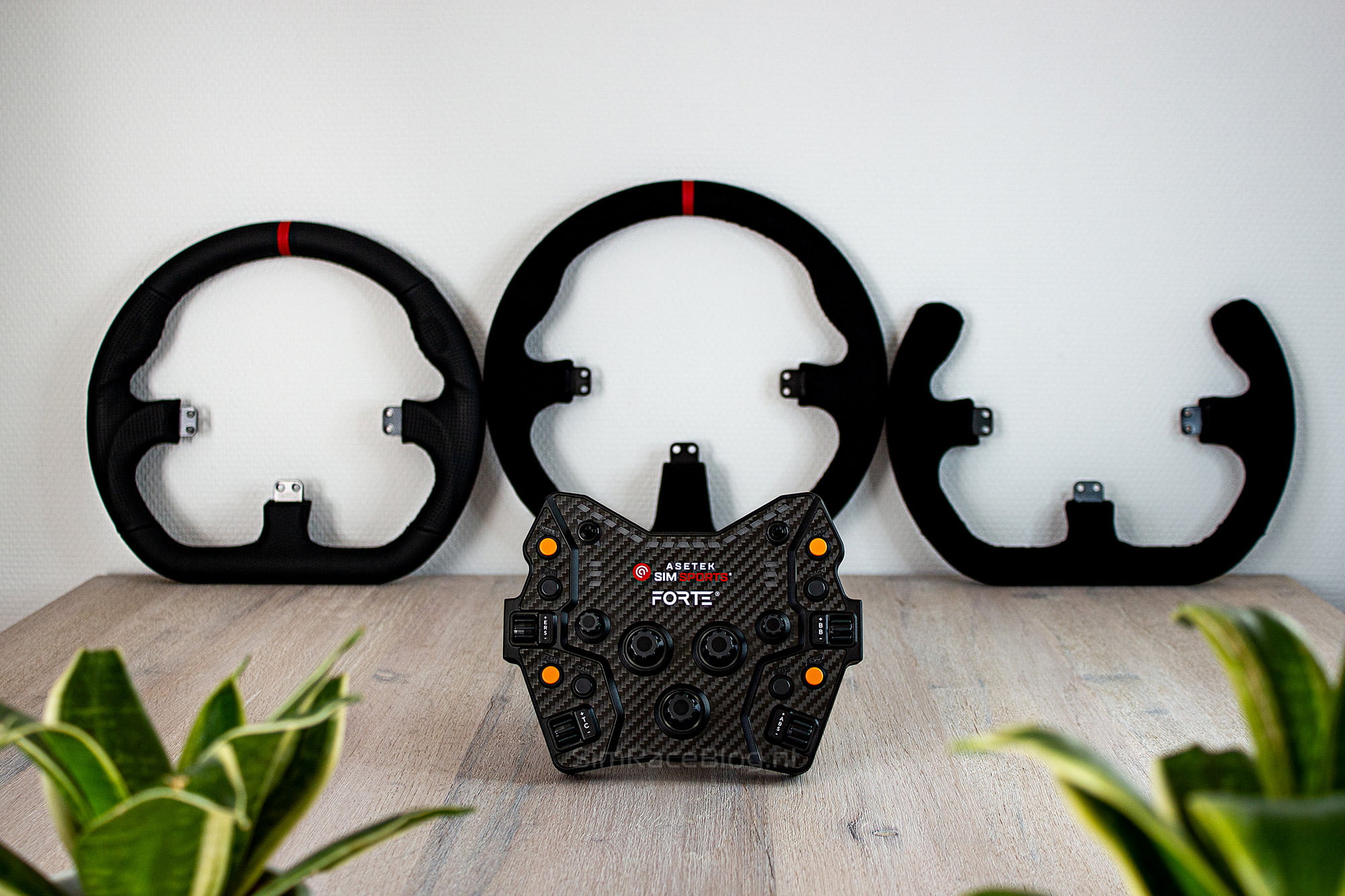
Packaging & Contents
After a brief 3-day journey, we received the package sent from Denmark at our doorstep via UPS. The delivery man handed us a large box filled with familiar white boxes adorned with the Asetek logo on the side. As the door closes and we place the boxes on the table, we can’t wait to get started.
The Button Box
The largest white box is expected to contain the button box. Upon opening the white box, we are somewhat surprised by its contents. Unlike Asetek’s usual product boxes with a sleek black sleeve, the product box for the Forte Button Box comes with a white sleeve. This white sleeve features Asetek branding and the recognizable red stripe at the bottom. On the front of the sleeve, the word “FORTE” is written prominently in large black letters, accompanied by a clear product photo on the right. A small but certainly not unnecessary detail on the front of the sleeve is the text in the bottom right corner stating, “Steering Wheel Rim NOT included,” making it explicitly clear that this is solely the button box. On the back of the sleeve, we find another clear product photo, accompanied by a brief piece of text about the RaceHub software and a small section about Asetek’s Quick Release (QR) system. Finally, there is a small list at the bottom titled “In the box,” detailing the contents of the box.
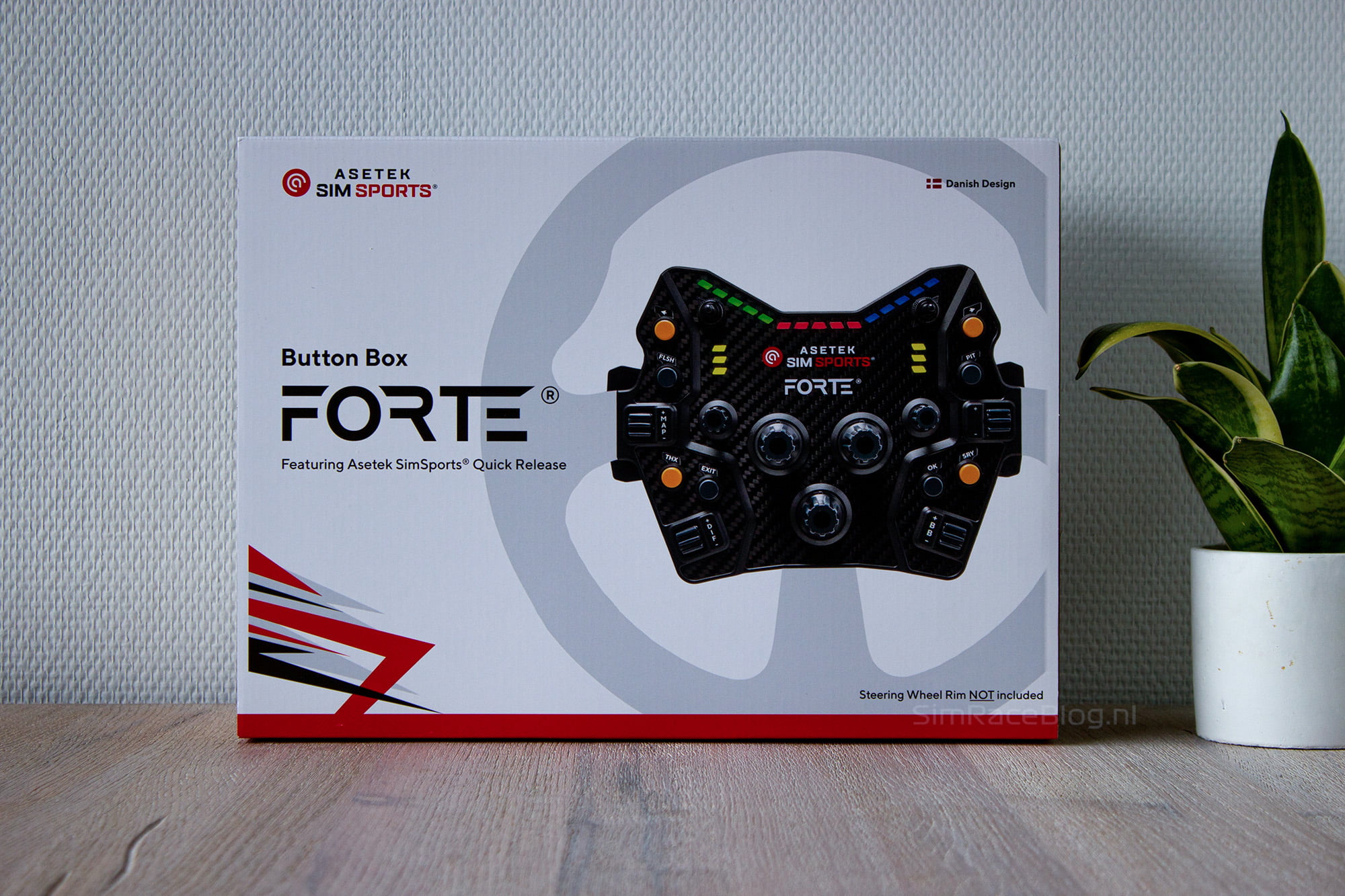


Upon removing the sleeve, the actual product box is revealed, featuring a standard brown cardboard appearance. This box has a simple look with Asetek branding all around and the words “NO LIMITS” prominently displayed on the lid. Upon opening the box, we are immediately greeted by the button box, which is placed in a sort of cardboard holder. Removing this top layer, we discover a second layer containing the individual shifter modules, the instruction manual card, warranty and safety instructions booklets, and finally, a small bag containing an Allen key and tweezers. Below this layer, we find the sticker sheets, with one sheet for the button box markings and the second sheet featuring Asetek branding stickers.





The Wheel Rims
Up next, we take the three wheel rims that we have received from their white boxes. One notable detail is that the wheel rims are once again adorned with the black sleeve featuring Asetek branding. Each box has a large product photo on the front of the sleeve. For each rim, a few unique features are listed next to it, such as “Genuine Suede” and “Red Center Stripe.” On the Button Box’s box, we found the message in the bottom right stating that only the Button Box is included, and no wheel rim is inside of the package. On the steering wheel boxes, we see the opposite. In the bottom corner of all three boxes, we find the text “Button Box NOT included.” The back of the sleeve prominently features the product photo once again. Here, the unique features of each steering wheel are highlighted, along with a reference to the steering wheel itself. Each box also includes a brief description providing information about the steering wheel. Finally, these sleeves have a short list of parts included in the box.






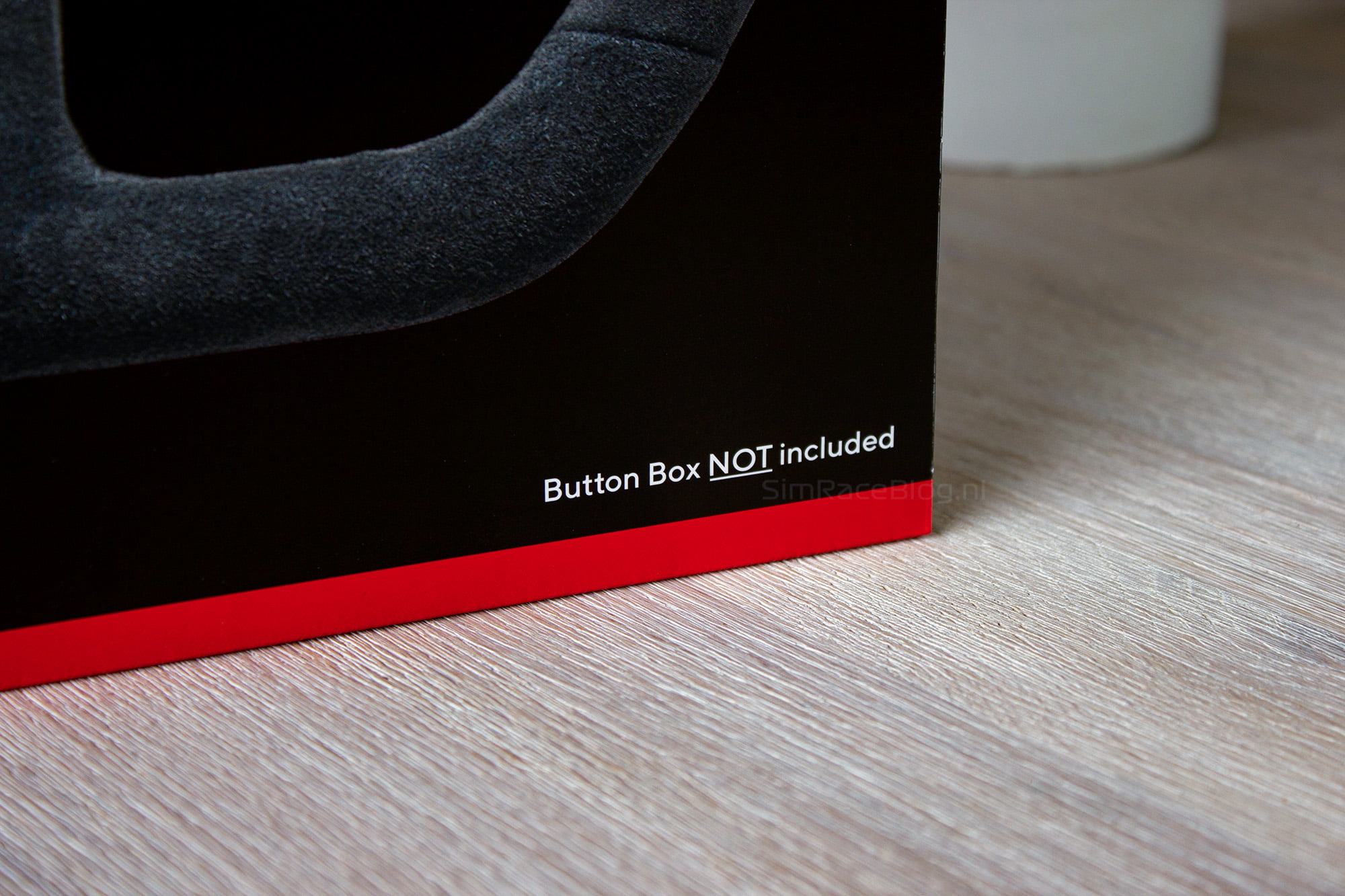
In essence, the boxes for the wheel rims are all the same, with the exception of the actual wheel rim inside. When we remove the black sleeve, a brown cardboard pizza box is revealed, featuring the text “NO LIMITS” on the lid. Upon unfolding the box, we find a neat fabric bag accompanied by two booklets. These are the warranty booklet and the safety booklet. Next to these we also find the card with a QR code linking to the manual. Safely packed in the fabric bag, we encounter the wheel rim in each box. At the bottom of the box, there is a small plastic bag containing an Allen wrench and six small screws, which can be used to attach each individual rim to the button box.






Engineering & Quality
As mentioned above, we received a substantial collection of products, with the Asetek Button Box literally taking center stage. The concept of the Asetek Button Box is quite simple: instead of having to purchase multiple complete steering wheels to change the wheel type, you only need to buy the actual rim of the wheel to switch between steering wheels. This means that you can easily switch from a round wheel to a D-shaped wheel and to an open D-shaped wheel at a relatively low cost. Simply unscrew the rim of your steering wheel and screw on the other variant. The only variation that is not possible is to turn it into a formula steering wheel. For that, the Forte Formula steering wheel needs to be purchased separately.
Forte Button Box
The Forte Button Box can be seen as the core of an adaptable steering wheel. As the name suggests, it is literally the central unit of the wheel where all buttons and input options are located. The housing of the Forte Button Box is made of a injection-molded composite material reinforced with the addition of carbon fibers, giving it an attractive forged carbon look. On the front of the Button Box, Asetek opted for a 2mm thick plate made of woven carbon fiber to provide the wheel with a traditional carbon fiber appearance. The front of the wheel is equipped with a total of 36 programmable aRGB LEDs, with 15 used for the RPM, six as flag lights, eight to illuminate the push buttons, four for the toggle switches, and three as backlighting for the rotary knobs
The LED lighting already gives it away a bit, but the Forte Button Box is equipped with eight push buttons, making it four buttons less than the Forte Formula steering wheel. Additionally, the Button Box features two seven-way rotary switches, one located on the left and one on the right of the front face. The advantage of these switches is that they can be pressed in four directions, used as encoders in two directions, and also pressed down as regular buttons. At the top of the wheel, in each upper corner, there is a toggle switch with a neutral resting position. Furthermore, the Button Box is equipped with four thumb encoders, located on both the left and right sides in the middle and at the bottom of the wheel. Compared to the formula steering wheel, which has six encoders, the two encoders at the top are missing. Last, in the center of the wheel, below the Asetek branding, there are three rotary knobs, each with 12 positions. With this configuration, it’s safe to say that there is no shortage of input options on the Forte Button Box.
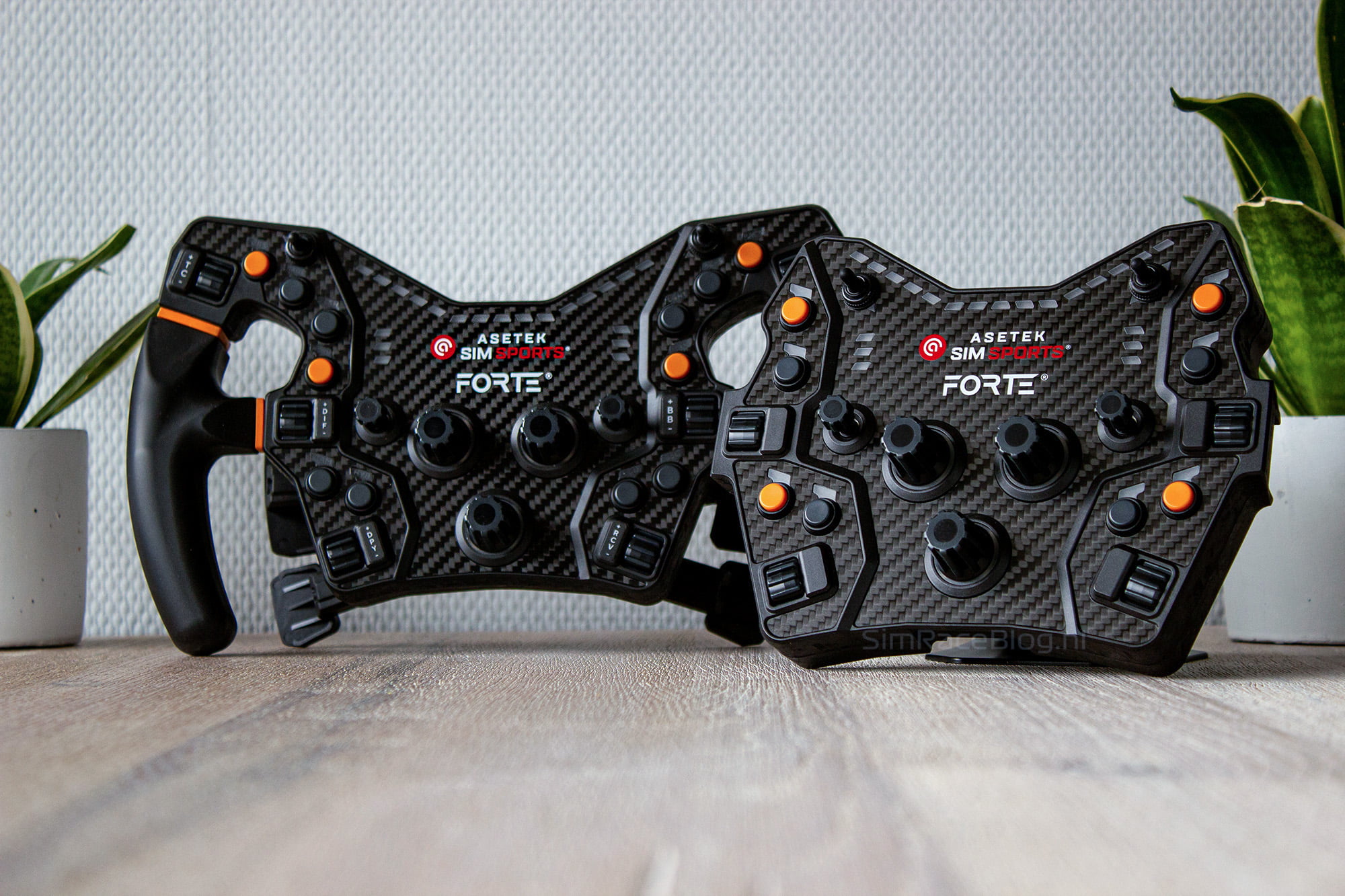
At the back of the Button Box, we find the Asetek quick release system seamlessly integrated into the Button Box’s housing. This quick release system provides power and telemetry data to the box when directly connected to an Asetek wheelbase. Additionally, at the back of the housing, there are six pre-formed cutouts with a deep hole at the end. These are the connections for the magnetic modules, including the shifter modules, Clutch Paddles, and Magnetic Input Paddles from Asetek, which operate on the magnetic Hall sensor principle. The beauty of this system is that all modules can be connected to the wheel without any wiring, and they are instantly recognized in the RaceHub software, making them literally connectable with a single screw to your Button Box. Ultimately, an essential element is located at the rear of the Button Box – the attachment points for the separate steering wheels. At the 3, 6, and 9 o’clock positions, there is a small recess, each with two screw holes. These holes should precisely align with the attachment points on the steering wheels, making it a matter of placing the wheel in the recesses and securing it with screws to connect it to the Button Box.

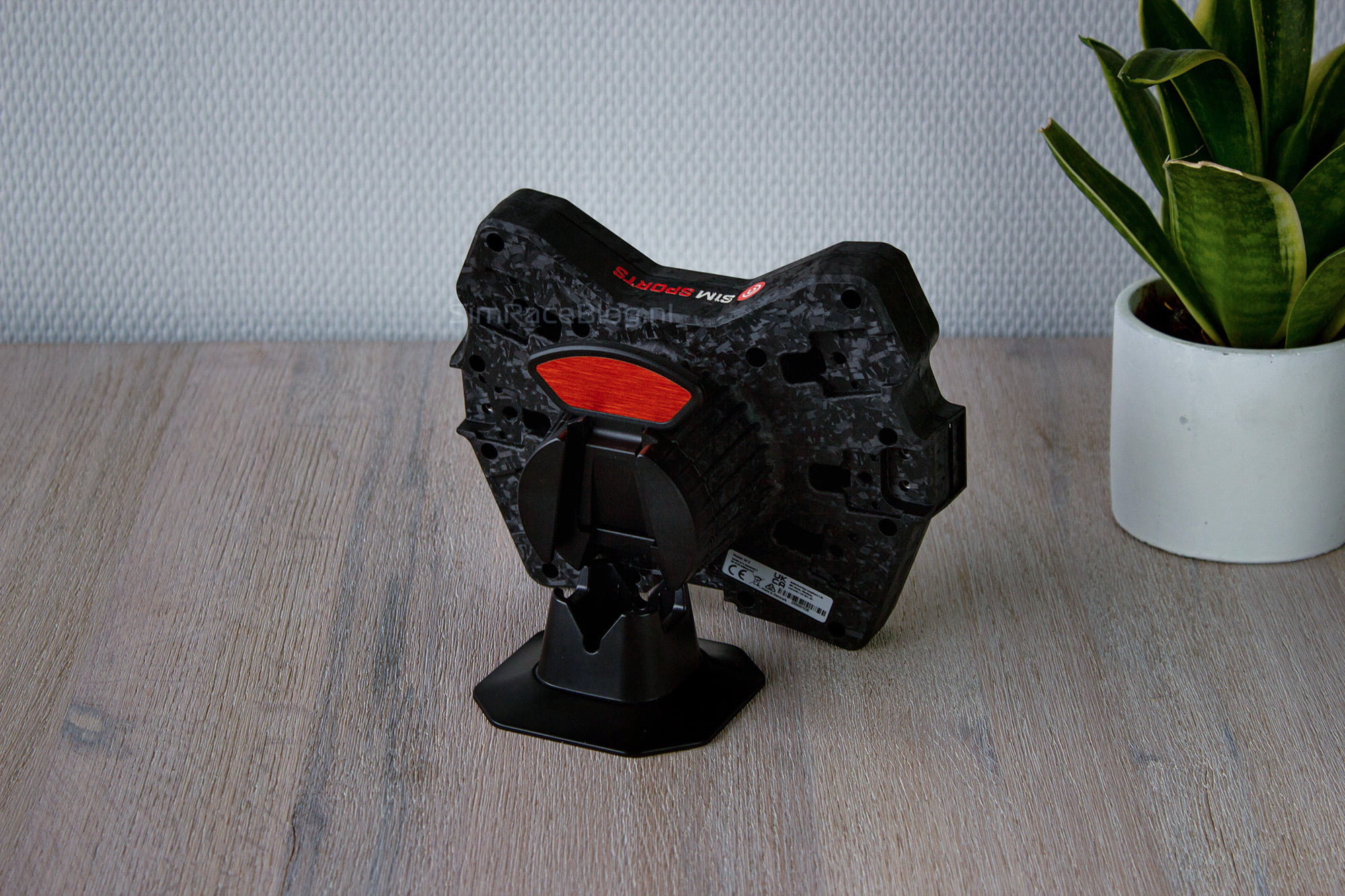






Closed D Black Leather Rim
The first steering wheel we received is the Closed D Black Leather steering wheel. As the name suggests, this is a wheel with a flat bottom giving it a D-shape, similar to those found in sportier street cars. The steering wheel, with a diameter of 330mm, is fully wrapped in black leather which has been hand-stitched for a polished look. While the top and bottom have a sleek, smooth appearance, the areas around the handgrips are covered with perforated leather for added grip and ventilation. An additional advantage of a leather steering cover is that the wheel is comfortable to use without gloves and stays in good condition for a long time. The last feature of this steering wheel is the red marker, made from a separate piece of red leather, at the top of the wheel indicating the 12 o’clock position. The Closed D steering wheel is also available in a variant with orange grips.




Open D Suede Steering Wheel
The second steering wheel we received is the Open D Suede steering wheel. Again, it is a wheel with a flattened bottom, also with a diameter of 330mm. However, because this is an Open D wheel, the top part of the wheel is absent, allowing for easier visibility over the wheel. The variant we received is manually covered with genuine suede, giving the steering wheel a classic and stylish race look while providing a high level of grip. When using a suede-covered steering wheel, it is recommended to use gloves, as the neat appearance of this fabric can quickly become dirty when in contact with bare hands. If you prefer racing without gloves, the Open D steering wheel is also available in a variant with black leather.




Round Comfort+ Rim
The third and final steering wheel that we get to form our opinion about is the Round Comfort+ steering wheel. As the name suggests, this is a fully round wheel suitable for activities such as rallying and drifting. The special feature of this 330mm round steering wheel is not so much its shape but its material. Unlike the previous steering wheels covered in leather and suede, this steering wheel is covered with Asetek’s proprietary material called Comfort+. This material, which has a suede look, is designed by Asetek for durability. The material requires minimal maintenance as it is claimed to be dirt-repellent and antistatic. This makes the steering wheel excellent for use without gloves. Additionally, the material is fire-resistant, which seems like a peculiar mention for a sim racing wheel, considering most rigs are not highly flammable. Finally, the Comfort+ material consists of 37% recycled materials, making it a more sustainable choice than regular suede. In addition to the Comfort+ material, the round steering wheel also features a small strip of red leather to mark the top of the wheel. If you prefer a leather steering wheel, the round wheel is also available in a leather variant with orange accents.
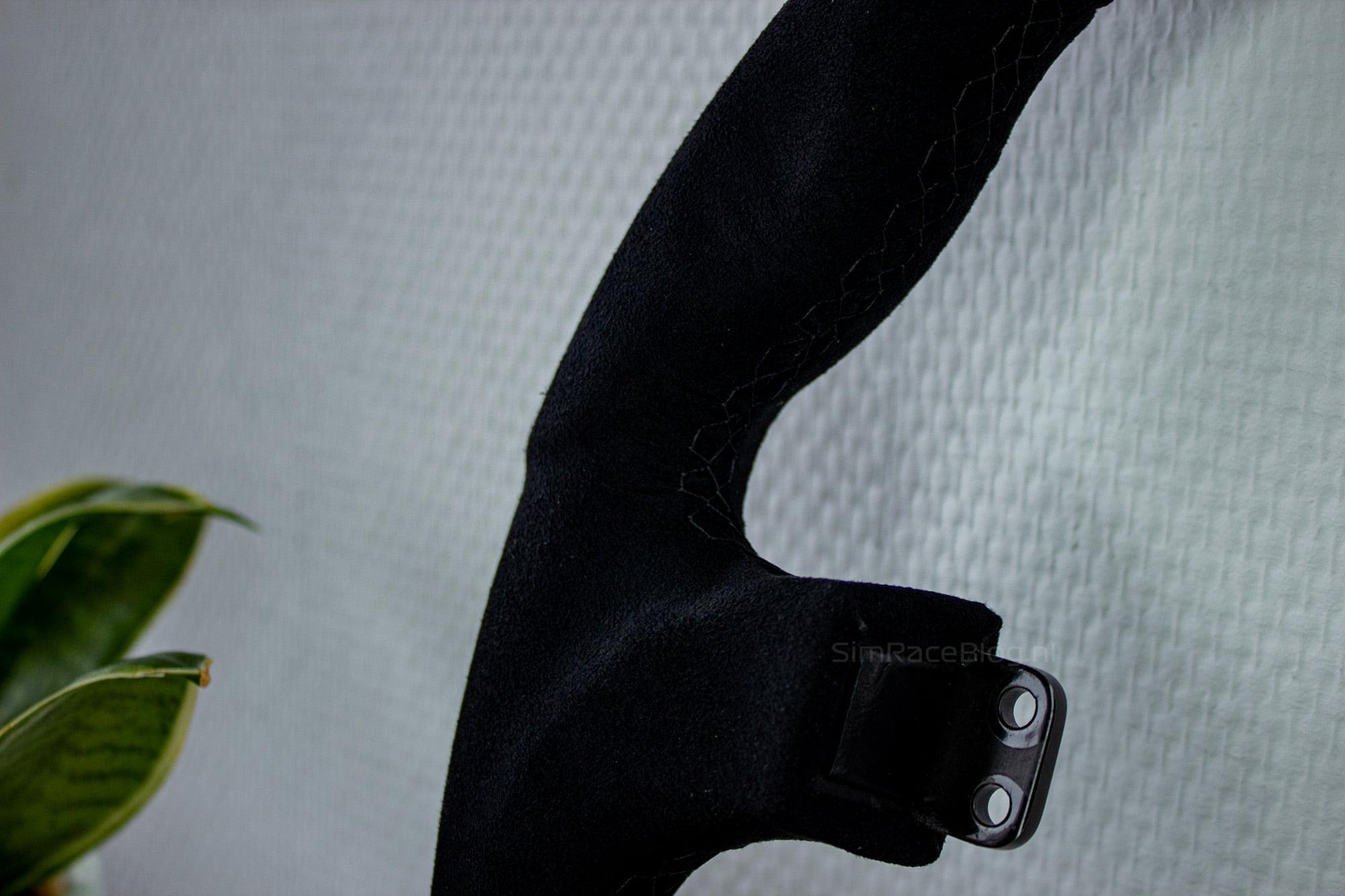
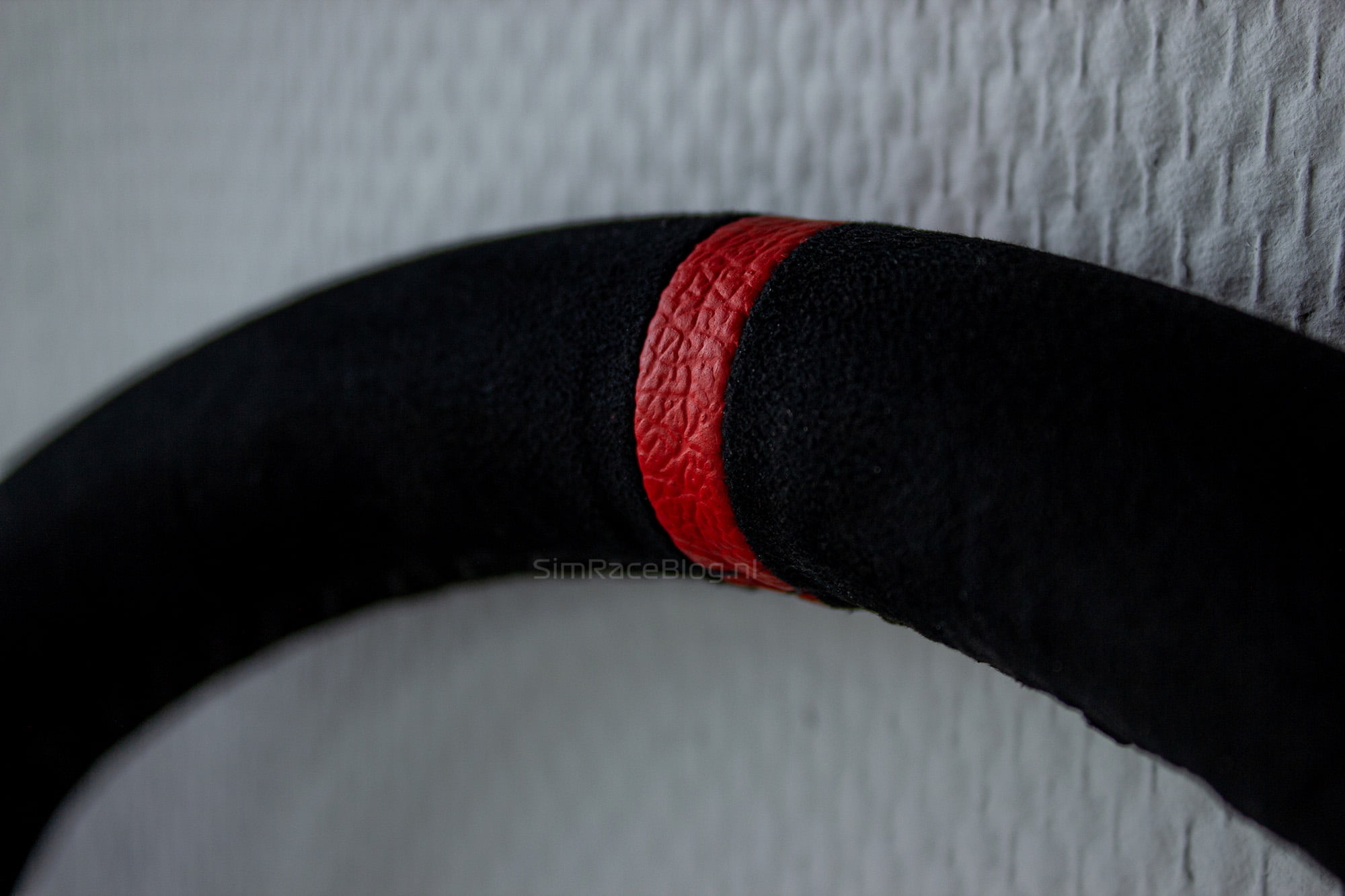
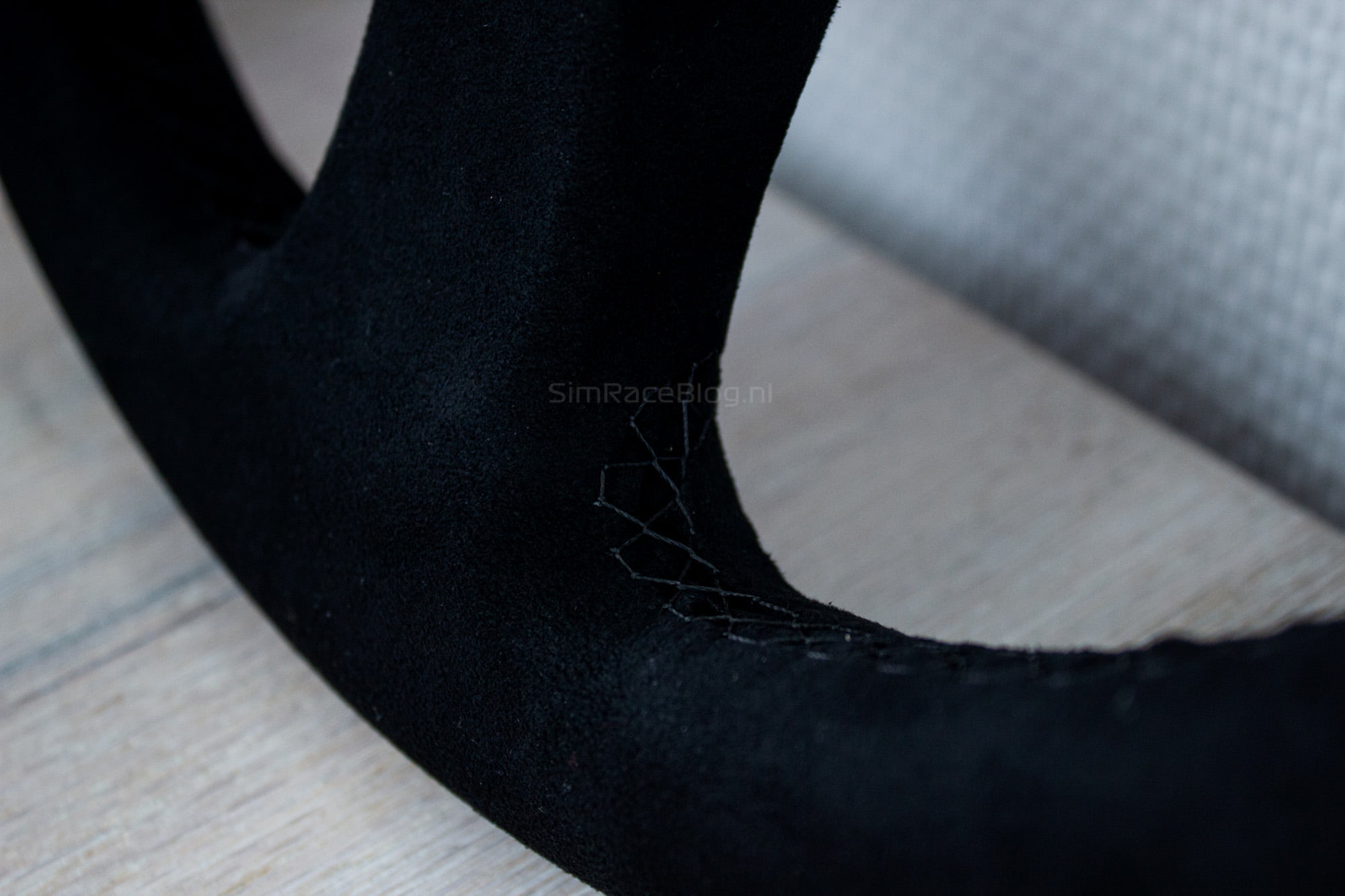
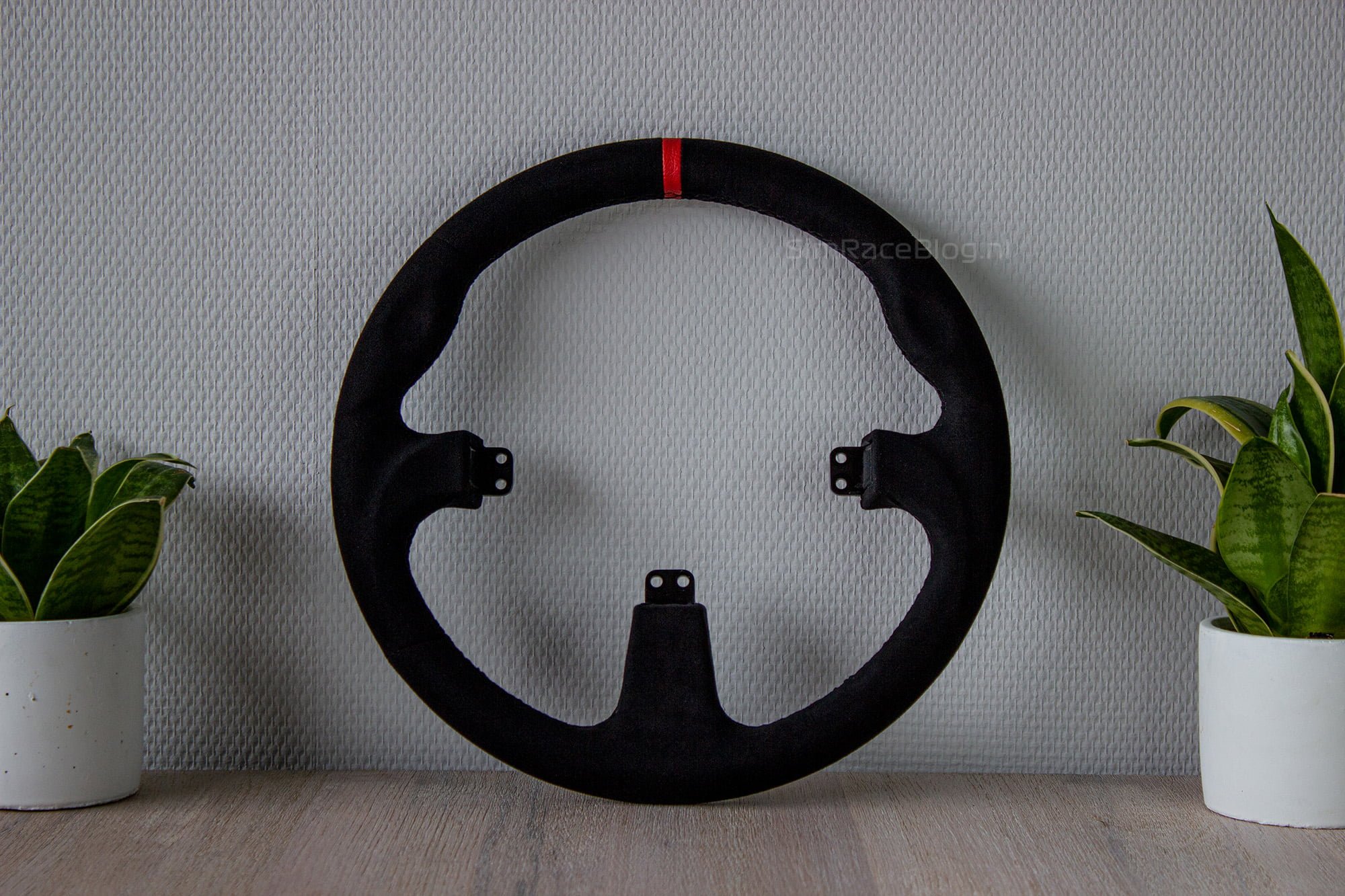
Assembly
Before we can start racing with the Button Box, we need to assemble it into a complete steering wheel. To begin, we attach the Closed D Black Leather wheel rim to the Button Box. This is done very easily with the provided screws and Allen key. On the back of the Button Box, there are three indentations where the wheel rim fits precisely, after which it can be secured with two small screws at each point. Now, the wheel rim is firmly attached to the Button Box.
The second step we take is attaching all the modules to the back of the Button Box. We start by attaching the included shifter modules. For these modules, we choose the middle connections on both sides of the steering wheel, as this is the most ergonomic option. These connections are very simple and completely wireless, working with the magnetic Hall sensor principle. This allows us to lower the modules into the recess, which can only be done in one way, and then the modules are in place. All we need to do is tighten the screw to ensure our shifter modules are securely in place. Initially, the screw used to attach the module to the Button Box is hidden behind the paddles themselves. When we loosen the screw on the module itself, the one which adjusts the width of the paddle, and set the paddle to its outmost position, the head of the mounting screw becomes visible. Then, it’s just a matter of tightening the screw, and our shifter modules are securely in place. One drawback we encountered when attaching our shifter modules is that the mounting screw is located in a hole right next to the paddle’s magnet. This causes the Allen key to be pulled to the side when we try to insert it into the screw, making it challenging sometimes to get the key properly into the screw. Another point, which is not necessarily a drawback but worth mentioning, is the position of the middle module connections. These are located at the same height as the attachment points of the wheel rim. When we have placed our shifter modules, they cover the mounting screws of the wheel rim, making them inaccessible. This means that if we want to change the steering wheel, we first need to remove our shifter modules, which does slow down the wheel-changing process.
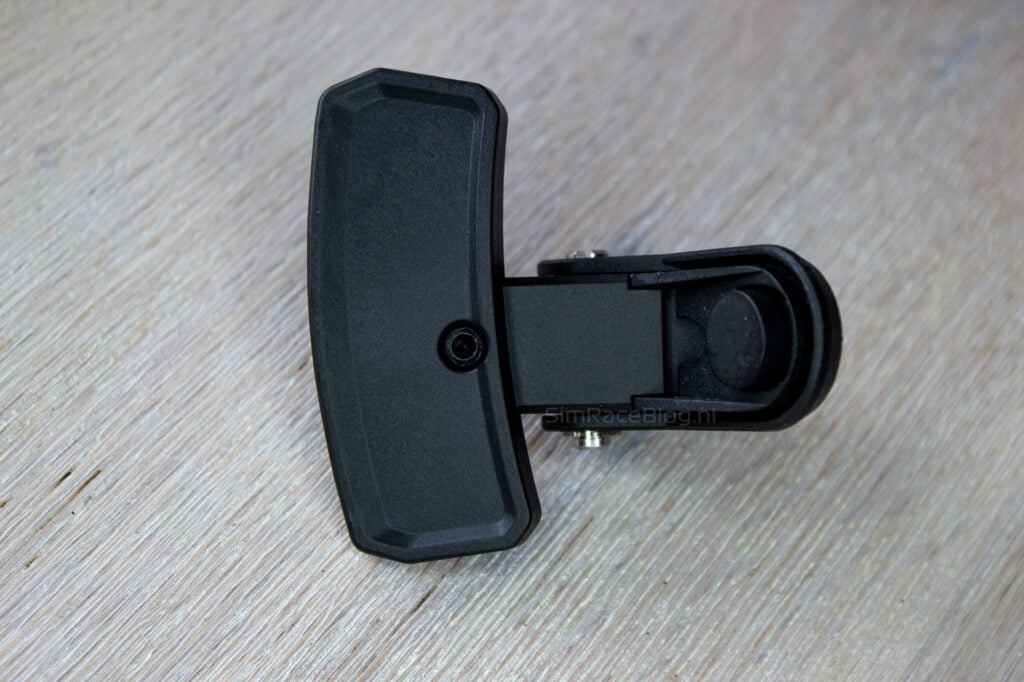
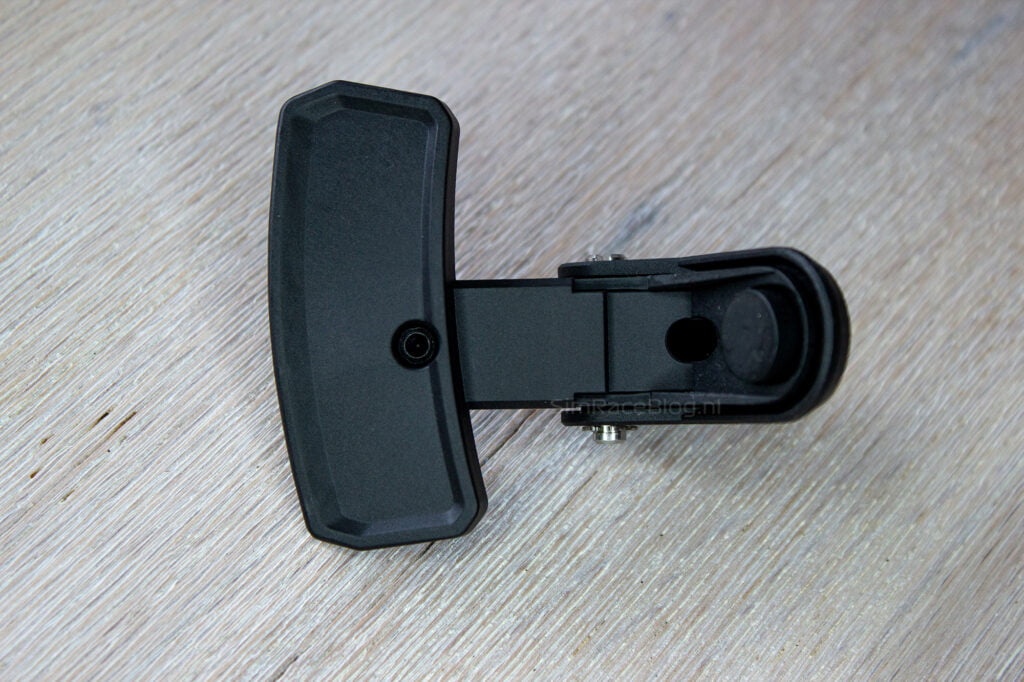
The last paddles we attach are the separately available Clutch Paddles from Asetek. The system for attaching these to the Button Box is the same as that of the shifter module, where the paddle must first be set to its furthest position before the module can be tightened. Fortunately, these clutch levers work with a spring, so we don’t have any interference from a magnet pulling on our Allen key.
The final touch to complete our steering wheel is, of course, sticker application. The sticker sheet provided with the Button Box offers a wide variety of stickers for almost every important function, covering the buttons and encoders. A nice detail with the stickers for the buttons is that they are printed in negative. When we apply these stickers to the illuminated area around the buttons, the text will be illuminated. Using the provided tweezers makes applying the stickers relatively easy, although sticker application always requires some precision work.






Software
Before the Forte Button Box is fully functional, the Asetek RaceHub software needs to be downloaded. We already have it on our PC due to other Asetek products on our rig. When we attach the Button Box to our Invicta wheelbase and turn on the wheelbase, it is automatically recognized. By clicking on “Steering Wheel” in the left menu bar, we are directed to the first tab in the Button Box menu called “Button Configuration.” In this menu, we see a visualization of the Button Box, and we can configure each button and knob. When setting the colors of the LEDs on the wheel, there is a choice of 14 different colors that can illuminate beside the buttons. We can also assign a separate color when a button is pressed, causing it to change color upon pressing. Since the LEDs can be quite bright, there is a slider to adjust the brightness of the button illumination. However, there are more configuration options offered in this menu. For each button, there is the option to use it as a “Push Button,” where the button acts as a regular push button, or as a “Latched Button,” where the button functions as an on/off switch. Similar options can be found for the rotary knobs. When using the “Position Based” option for the rotary knobs, it remembers the position between 1-12 where the knob is located. With the second option, “Incremental,” the rotary knob can be used as an encoder, providing a short signal pulse with each turn.


The second tab, named “Shift Lights,” is exactly intended for what the name suggests: setting up lighting that displays your RPM. In this menu, we can assign one of the 14 colors to each LED and determine at what percentage of the maximum RPM it should light up. We can do the latter by choosing a pattern from the drop-down menu or by sliding the slider up or down for each individual LED. Initially, the ability to adjust individual LEDs is locked to prevent accidental changes. By toggling the “Adjust Shift Curve” button, the overview becomes more colorful, indicating that the sliders are now available. The RaceHub software also allows us to run the LEDs with a linear, progressive, or regressive curve. Finally, similar to the button LED lighting, there is a slider for adjusting the brightness of the lighting, giving us control over the light intensity.
The last section of the Button Box menu is the “Flag Lights” section. This is a very simple menu where we can only turn on or off pre-programmed flag LEDs. Something we secretly find a bit unfortunate since we like the flexibility of being able to determine the color pattern for each situation ourselves. Finally, this tab also features a slider to adjust the intensity of the six flag lights.




Using the Forte Button Box
With everything configured and in place, we are ready to take our first laps with our new Asetek steering wheel. To test all the different steering wheels, we’ll be driving various GT cars and NASCAR in Assetto Corsa, as well as trying our hand at drifting. Additionally, we’ll be using DiRT Rally 2.0 to gain some off-road experience.
Forte Button Box
Our initial impression of the Forte Button Box is quite positive. The layout of the buttons on the front feels familiar quickly, allowing us to find the buttons without needing to look at the wheel. The buttons themselves provide a satisfying feedback when pressed, with a pleasant resistance that requires a firm push to activate. When pressed, they emit a distinct click that is both felt and heard, and combined with an LED changing color upon activation, it’s impossible to miss when a button is pressed. One small note we’d like to make about the Button Box’s push buttons is that they might be a bit too far from the edge of the wheel. While we have average-sized hands, we find ourselves having to stretch our thumbs quite a bit to reach even the buttons placed farthest outward. For sim racers with smaller hands, this might mean they need to loosen their grip slightly to reach the buttons comfortably.
The thumb encoders on the wheel, on the other hand, are conveniently placed and easily accessible. Despite being somewhat recessed into the wheel, they are easy to operate. They also provide a nice amount of resistance during operation, allowing for controlled scrolling through the positions, each of which is distinctly palpable. The rotary knobs in the middle of the wheel are also enjoyable to use, offering a similar resistance during operation. A noteworthy feature is the illumination around the rotary knobs, making them easily visible in your peripheral vision. This way, you don’t have to take your eyes off the virtual track to operate them.
At the back of the Button Box, several elements deserve attention. First and foremost, we want to mention that the Asetek QuickRelease system remains one of the most pleasant systems to work with in our opinion. Using only one hand, we can squeeze the QuickRelease lever, allowing us to remove the wheel from our wheelbase instantly. Changing a wheel with this system literally takes just a few seconds. Alongside the QuickRelease, you’ll find the shifter paddles on the back. While many manufacturers use a metal system, Asetek has made their shift modules from plastic. The advantage of this is that they produce relatively little noise during shifting. Regarding operation, we can’t say much except that they feel good, provide excellent feedback, and are easy to reach with the fingers when holding the wheel firmly. Due to the magnets on the paddles, we need to assertively operate them, making it almost impossible to accidentally activate one of the shifter paddles while driving. Finally, we’ve also mounted the clutch paddles on the Button Box. The clutch on the wheel is easy to operate with our pinky and ring finger. When we pull only one of the two clutch levers, it functions as a full-range clutch. It gets more interesting when we operate both clutch levers, as they automatically switch to the master-slave principle. This allows us to release one lever when the start lights go out, automatically reaching a predetermined release point. With the second lever, we can then modulate to smoothly launch. The release point is easily adjustable in the RaceHub software, allowing us to fine-tune it with a few practice starts to achieve the perfect point.
Closed D Black Leather Wheel Rim
With just a Button Box, we obviously can’t race. As mentioned earlier, we started by mounting the Closed D Black Leather wheel rim. This proved to be a good choice for a first impression, as it is a very comfortable steering wheel. Beyond its sleek appearance with (perforated) leather, the steering wheel provides a remarkably comfortable feel. Whether with or without gloves, the wheel sits nicely in the hand, allowing for multiple extended sessions without any noticeable drawbacks. In addition to the pleasing material sensation, the 330mm diameter feels natural, and the wheel has a comfortable thickness for a secure grip.


Changing Rims
The second wheel rim we’re attaching to the Button Box is the Open D Suede wheel rim. It takes us about five minutes to remove the shifter modules, take off the Closed D Black Leather rim, install and secure the Open D Suede rim, and finally, reattach the shifter modules. It’s not a task that can be done “quickly” between sessions, but we’d still consider it relatively swift. However, the downside remains the magnets on the shifter modules. Similar to assembling the wheel, we notice that the magnet constantly pulls the Allen key, making it somewhat challenging to insert the key properly into the screw embedded deep within the shifter module’s housing. Even when pulling the Allen key out of the hole, it gets drawn toward the magnet, making it easy to accidentally scratch the shifter module.
Open D Suede Wheel Rim
With the Open D Suede wheel rim in place, we can also start driving with it. The steering wheel feels (not surprisingly) almost the same as the Closed D steering wheel. A significant advantage of this design is that, in the Formula seating position, there is much more visibility of the screen. Therefore, the Open D steering wheel is a suitable choice for us to drive GT cars, for example, without needing to use a Formula-style wheel that may partially block the screen. The suede covering of the steering wheel feels very soft to the touch without gloves. However, it’s advisable to drive with gloves to keep the fabric looking neat for a longer time, so that’s what we do. With gloves on, the steering wheel still feels comfortable, just as we experience with its closed variant.



Round Comfort+ Wheel Rim
The last wheel rim we are working with is the Round Comfort+ rim, which we use both with and without gloves. The first thing that stands out with this steering wheel is that the Comfort+ covering feels wonderfully soft in our hands while providing good grip. This is advantageous when rally driving or navigating the virtual circuit. However, for drifting, there is a slight downside in that we can’t smoothly let the steering wheel slide through our hands without the risk of “carpet burn.” If you intend to use the round steering wheel for drifting, we recommend either driving with gloves or opting for the leather variant of the round wheel. Otherwise, the round wheel shares a similar design with the other two steering wheels, featuring a comfortable shape that feels good in the hands and provides a secure grip.



Conclusion
All in all, we are quite impressed with the Asetek Forte Button Box. While a Button Box with detachable wheel rims is not a new concept, we find it a positive development to see Asetek offering this option in a well-executed manner.
The Button Box itself features the quick Asetek Quick Release and provides ample input options. With eight push buttons, four thumb encoders, three rotary knobs, two kinky switches, and two toggle switches, we have more than enough options for input commands into our games. Additionally, the Button Box is generously equipped with LED lighting for RPM, track flags, and a separate LED for each push button that we can assign a color to. The included plastic shifter modules feel good and produce minimal noise while providing good feedback during shifting. The optional Clutch Paddles also feel natural and are easy to adjust via Asetek’s RaceHub software. However, the Button Box is not entirely free from criticism. We find the assembly of the shifter modules less pleasant due to the magnet of these modules making it more challenging to insert the Allen key into the head of the deep-seated screw. When we want to swap the detachable rims, these shifter modules must be removed from the Button Box before we can install the new wheel rim.
We are also positive about the wheel rims we tested. The Closed D Black Leather, Open D Suede, and Round Comfort+ wheel rims were all experienced as comfortable. The Closed D Black Leather rim has a pleasant shape that can be gripped firmly. The combination of regular and perforated leather gives it a sleek appearance and a comfortable feel. The Open D Suede rim has the same ergonomic shape, with only the top of the wheel omitted. The suede on the steering wheel gives it a stylish racing look and provides good grip when driving with gloves. The Round Comfort+ rim feels wonderfully soft and offers a good level of grip. For rally driving or normal circuit use, the wheel rim can be comfortably used without gloves. If you plan to drift, we recommend opting for the leather variant or driving with gloves.
The Forte Button Box (€387.19 incl. VAT), Clutch Paddles (€45.97 incl. VAT), Closed D Black Leather Steering Wheel (€120.99 incl. VAT), Open D Suede Steering Wheel (€120.99 incl. VAT), and Round Comfort+ Steering Wheel (€163.34 incl. VAT) are all available through Asetek’s official webshop. If you use the discount code “simraceblognl,” you will receive an additional 5% off your order.
Do you want to stay informed about SimRaceBlog content, news, announcements and (future) give-aways? Follow us on Instagram @simraceblognl and/or our Discord channel.













